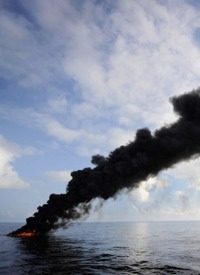
On Tuesday President Obama announced his "battle plan" regarding the Gulf of Mexico oil leak in a televised address from the Oval Office. He opened his comments reminding Americans of other challenges facing the nation: the current recession and the ongoing "war" in Afghanistan (despite his 2007 campaign promise that ending the war would be "the first thing I will do" as President). He said we’re now waging a war "against an oil spill that is assaulting our shores and our citizens."
Obama claimed "there has never been a leak this size at this depth," but others say the situation is not as catastrophic as the President’s melodramatic diatribe indicates. Robert Nelson with the Miami Herald reports the Coal Oil Point seep field near Santa Barbara, California, leaks 150 to 200 barrels of oil every day with no adverse consequences. He also cited a World War II German U-boat attack on eight tankers in the Gulf of Mexico which spilled more than 18 million gallons. The environment recovered soon afterward, largely on its own.
A worse spill in the Gulf of Mexico occurred in 1979 when a blowout on the Mexican oil rig Ixtoc resulted in a leak that lasted nearly 10 months and dumped roughly 3.3 million barrels of crude into the Gulf. And by far the largest spill in U.S. history is California’s Lakeview gusher, which spewed 378 million gallons of oil on dry land over the course of 18 months from 1910 to 1911. (Apparently, Obama is still unaware of Lakeview, since he claims the BP spill "is the worst environmental disaster America has ever faced.") However, in both Ixtoc and Lakeview cases, the environment had largely or completely recovered within a five-year period. Experts predict the same recovery rate in the Gulf.
To put the current spill even more into perspective, author and regular TNA contributor Ed Hiserodt calculated that the Gulf of Mexico, which contains 660 quadrillion gallons of water, is one trillion times larger than an Olympic swimming pool, which holds 660,000 gallons. At the worst-case estimate of 1,680,000 gallons per day, the BP well would dump 610 million gallons into the Gulf in one year. One trillionth of that amount is 0.00061 gallons, which equates to 0.00244 quarts or 0.078 ounces or 1.56 drops. "Therefore the oil spill — if as bad as the worst report and lasting for a full year — would be the equivalent of one-and-one-half drops of oil in an Olympic pool," said Hiserodt.
These statistics aren’t meant to downplay the obvious immediate effects on Gulf states’ residents and their property. But it does call into question Obama’s motives behind the catastrophic picture he painted in his televised speech Tuesday night. After weaving a tale of horror and devastation in the Gulf states, he said his "Gulf Coast Restoration Plan" would be more than a clean-up and recovery effort, encompassing restoration from hurricane damage and years of poor economic planning. "Beyond compensating the people of the Gulf in the short term, it’s also clear we need a long-term plan to restore the unique beauty and bounty of this region," the President opined. "That’s why we must make a commitment to the Gulf Coast that goes beyond responding to the crisis of the moment." He said BP will pay for the impact of the spill. But Obama was less explicit about who would foot the bill for his long-term plans which economists quoted in the Washington Post estimated would run around $30 billion over the next decade.
In his "President-as-savior" role, Obama also failed to mention the Gulf spill has reached its supposed epic proportions largely owing to federal delays. According to a 1994 federal response plan agreement, the government was supposed to keep clean-up equipment on hand in the region in case of a major Gulf oil spill. Ron Gourget, a former federal oil spill response coordinator who helped draft the 1994 plan told the Times of London, had the government held up its end of the bargain, roughly 95 percent of the spill would have been contained immediately. Owing to delays, the slick spread too far for the original plan to be effective.
Adding insult to injury, Obama has also pulled the plug in offshore drilling in the Gulf, imposing a six-month moratorium on an industry that accounts for 16 percent of Louisiana’s economy. "In a knee-jerk move with perverse consequences, the President’s total ban on drilling in the Gulf has created further hardship for communities already reeling from the impact of the BP spill," said Myron Ebell in a Freedom Action press release. "Now in addition to the tourism and fishing sectors … the oil and gas sector … is also being knocked down at exactly a time when its high-paying jobs could be helping to support families in the region."
Yet Obama’s plans promise even further and more widespread economic devastation. He closed Tuesday night’s speech with a call to end "America’s century-long addition to fossil fuels" through a "comprehensive energy and climate bill," referring to H.R. 2454 which passed the house last year. The U.S. Treasury Department released a 2009 analysis of the cap-and-trade bill indicating the cost to American taxpayers would be approximately $393 billion per year. Companion legislation in the Senate, the Kerry-Lieberman "American Power Act," promises equal economic havoc. "There are some who believe that we can’t afford those costs right now. I say we can’t afford not to change how we produce and use energy," said Obama.
Others don’t see several billion dollars a year as simple pocket change, and they view Obama’s shameless opportunism over the situation in the Gulf as a threat to the nation’s energy future rather than a promise of its independence. The Domestic Energy Producers Alliance says both Obama’s offshore drilling moratorium and "onerous" cap-and-trade proposals are direct attacks on the domestic independent oil industry. Referring to the BP spill, DEPA President Mike Cantrell said, "Let’s focus on the actual problem and not on off-target political agendas."
Photo: AP Images




